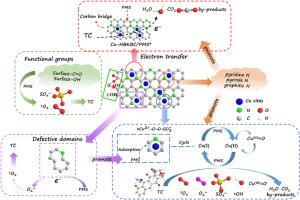缺陷驱动双功能Cu/N共掺杂生物炭同步吸附和瞬间催化降解有机污染物
IF 8.4
2区 环境科学与生态学
Q1 ENVIRONMENTAL SCIENCES
引用次数: 0
摘要
作为医疗保健和畜牧业生产中常用的抗生素,四环素(TC)残留在水体中,对生态和健康构成威胁,因此从废水中有效去除四环素至关重要。合成了一种铜(Cu)和氮(N)共掺生物炭(BC)催化剂(表示为Cu-N@KBC),该催化剂具有低能耗、优异的吸附能力和优异的催化性能。Cu-N@KBC在20 min内脱除了35.2%的TC,固液分布系数(Kd)为4.541 L g−1,这是由于其孔隙结构发育良好,缺陷位点丰富。N掺杂到sp2杂化碳网络中,与均匀的Cu负载协同耦合,诱导氧空位和表面缺陷的形成,从而为TC吸附创造了额外的活性位点。在优化后的条件下,60 min内最大降解率为96.5%。Cu和N的结合提高了石墨化程度(ID/IG = 0.93),优化了电子转移并促进了≡Cu2+-O-O-SO3的构型。这进一步加速了Cu+/Cu2+氧化还原循环和活性氧(ROS)(•OH、SO4•−、O2•−、1O2和CuIII=O)的生成。此外,Cu-N@KBC/过氧单硫酸酯(PMS)体系表现出优异的稳定性、通用性和抗干扰性。值得注意的是,它与膜技术的结合显示了Cu-N@KBC-cellulose醋酸膜在实际废水处理应用中的潜力。该研究为Cu-N@KBC/PMS/TC体系的吸附机理和o2主导的非自由基降解途径提供了新的视角。本文章由计算机程序翻译,如有差异,请以英文原文为准。

Defect-driven bifunctional Cu/N co-doped biochar for synchronized adsorption and instant catalysis in organic pollutant degradation
As a commonly used antibiotic in healthcare and livestock production, tetracycline (TC) remains in water bodies and poses ecological and health risks, making its efficient removal from wastewater essential. A copper (Cu) and nitrogen (N) co-doped biochar (BC) catalyst (denoted as Cu-N@KBC) was synthesized, exhibiting low energy consumption, excellent adsorption capacity, and superior catalytic performance. Cu-N@KBC achieved 35.2 % TC removal within 20 min, with the solid-liquid distribution coefficient (Kd) of 4.541 L g−1, owing to its well-developed pore structure and abundant defect sites. N doping into the sp2-hybridized carbon network, synergistically coupled with uniform Cu loading, induced the formation of oxygen vacancies and surface defects, thereby creating additional active sites for TC adsorption. A maximum TC degradation of 96.5 % was achieved within 60 min under the optimized conditions. The combined incorporation of Cu and N elevated the graphitization degree (ID/IG = 0.93), optimizing electron transfer and facilitating ≡ Cu2+-O-O-SO3 configuration. This further accelerated the Cu+/Cu2+ redox cycle and the generation of reactive oxygen species (ROS) (•OH, SO4•−, O2•−, 1O2, and CuIII=O). Additionally, the Cu-N@KBC/peroxymonosulfate (PMS) system demonstrated excellent stability, universality, and resistance to interference. Notably, its integration with membrane technology demonstrated the potential of the Cu-N@KBC-cellulose acetate membrane for practical wastewater treatment applications. This study offered a fresh perspective on the adsorption mechanism and the 1O2-dominant non-radical degradation pathway of Cu-N@KBC/PMS/TC system.
求助全文
通过发布文献求助,成功后即可免费获取论文全文。
去求助
来源期刊

Journal of Environmental Management
环境科学-环境科学
CiteScore
13.70
自引率
5.70%
发文量
2477
审稿时长
84 days
期刊介绍:
The Journal of Environmental Management is a journal for the publication of peer reviewed, original research for all aspects of management and the managed use of the environment, both natural and man-made.Critical review articles are also welcome; submission of these is strongly encouraged.
 求助内容:
求助内容: 应助结果提醒方式:
应助结果提醒方式:


